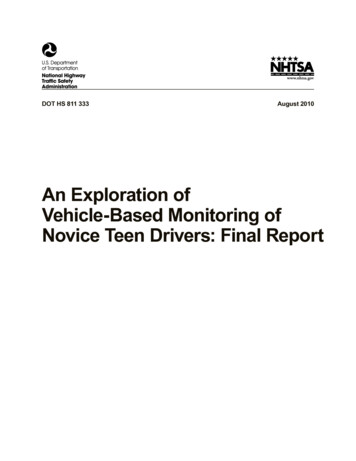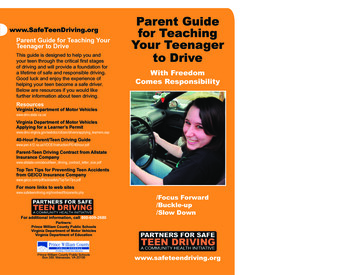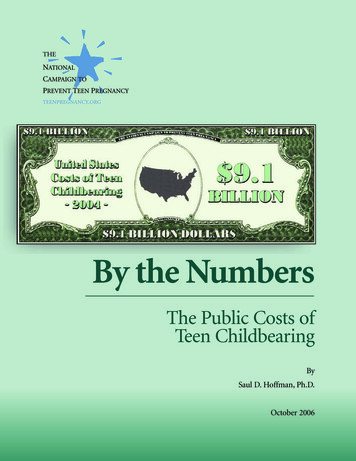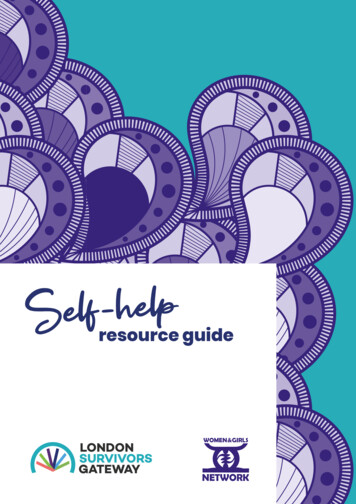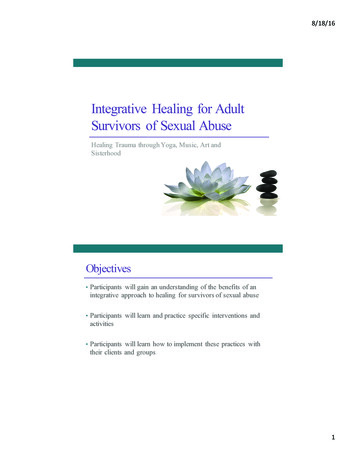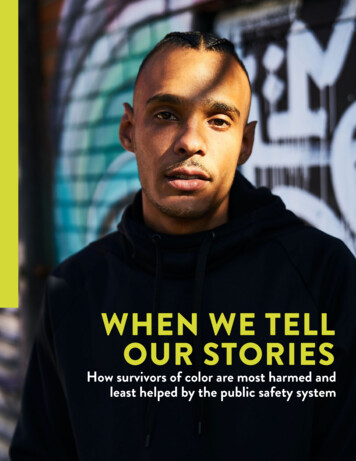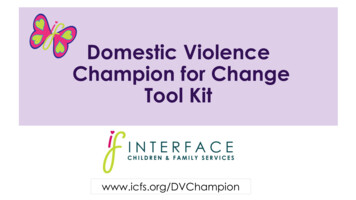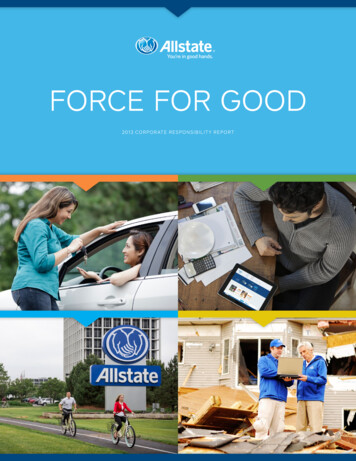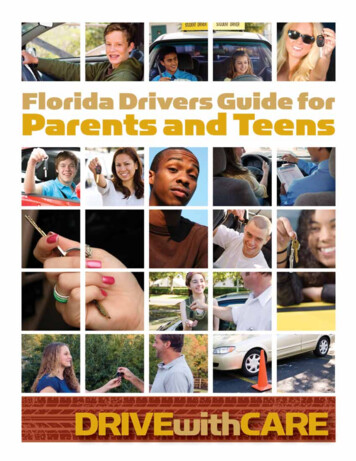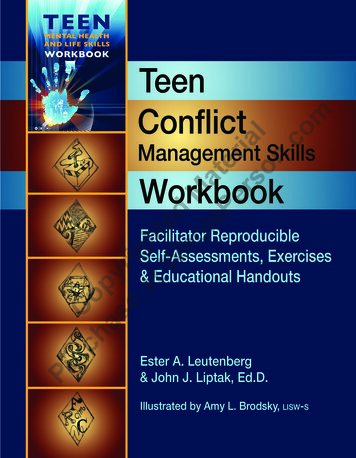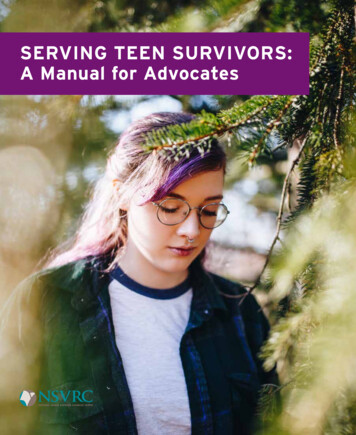
Transcription
SERVING TEEN SURVIVORS:A Manual for Advocates
Serving Teen Survivors: A Manual for Advocates. Harrisburg, PA: National Sexual Violence Resource Center. National Sexual Violence Resource Center 2018. All rights reserved.This project was supported by Grant No. 2011-TA-AX-K023 awarded by the Office on Violence Against Women,U.S. Department of Justice. The opinions, findings, conclusions, and recommendations expressed in thispublication are those of the author(s) and do not necessarily reflect the views of the Department of Justice,Office on Violence Against Women.The content of this publication may be reprinted with the following acknowledgment: This material wasreprinted, with permission, from the National Sexual Violence Resource Center’s publication entitled ServingTeen Survivors: A Manual for Advocates. Also available online at the Lifespan webpage of National SexualViolence Resource Center website: www.nsvrc.org/lifespan-project
Table of ContentsIntroduction . . . . . . . . . . . . . . . . . . . . . . . . . . . . . . . . . . . . . . . . . . . . . . . . . . . . . . . . . . . . . . . . . . . . . . . . . . 3SECTION 1Teenagers & Sexual Violence . . . . . . . . . . . . . . . . . . . . . . . . . . . . . . . . . . . . . . . . . . . . . . . . . . . . . . . . . . .5SECTION 2The Teen Brain and the Impact of Trauma . . . . . . . . . . . . . . . . . . . . . . . . . . . . . . . . . . . . . . . . . . . . . . .9SECTION 3Tip Sheets on Working with Teens who are Survivors . . . . . . . . . . . . . . . . . . . . . . . . . . . . . . . . . . . . 15TIP SHEET: Hotline/Helpline. . . . . . . . . . . . . . . . . . . . . . . . . . . . . . . . . . . . . . . . . . . . . . . . . . . . . . . . . . . . . . 16TIP SHEET: Counseling/Advocacy . . . . . . . . . . . . . . . . . . . . . . . . . . . . . . . . . . . . . . . . . . . . . . . . . . . . . . . . . 19TIP SHEET: Peer-Led Services . . . . . . . . . . . . . . . . . . . . . . . . . . . . . . . . . . . . . . . . . . . . . . . . . . . . . . . . . . . . 21TIP SHEET: Supporting Significant Others . . . . . . . . . . . . . . . . . . . . . . . . . . . . . . . . . . . . . . . . . . . . . . . . . 22TIP SHEET: Alternative Modalities . . . . . . . . . . . . . . . . . . . . . . . . . . . . . . . . . . . . . . . . . . . . . . . . . . . . . . . . 25TIP SHEET: Legal Advocacy . . . . . . . . . . . . . . . . . . . . . . . . . . . . . . . . . . . . . . . . . . . . . . . . . . . . . . . . . . . . . . 26TIP SHEET: Court Accompaniment . . . . . . . . . . . . . . . . . . . . . . . . . . . . . . . . . . . . . . . . . . . . . . . . . . . . . . . . 27TIP SHEET: Law Enforcement Accompaniment . . . . . . . . . . . . . . . . . . . . . . . . . . . . . . . . . . . . . . . . . . . . . 29TIP SHEET: Medical Accompaniment . . . . . . . . . . . . . . . . . . . . . . . . . . . . . . . . . . . . . . . . . . . . . . . . . . . . . .30TIP SHEET: Information & Referral . . . . . . . . . . . . . . . . . . . . . . . . . . . . . . . . . . . . . . . . . . . . . . . . . . . . . . . . 33TIP SHEET: Agency Walkthrough . . . . . . . . . . . . . . . . . . . . . . . . . . . . . . . . . . . . . . . . . . . . . . . . . . . . . . . . . 35SECTION 4Confidentiality & Mandated Reporting Laws . . . . . . . . . . . . . . . . . . . . . . . . . . . . . . . . . . . . . . . . . . . .37SECTION 5Serving Teens in a Culturally Responsive Way . . . . . . . . . . . . . . . . . . . . . . . . . . . . . . . . . . . . . . . . . . . 41SECTION 6Annotated Bibliography: Sexual Violence and Teens . . . . . . . . . . . . . . . . . . . . . . . . . . . . . . . . . . . . .47SECTION 7Resources. . . . . . . . . . . . . . . . . . . . . . . . . . . . . . . . . . . . . . . . . . . . . . . . . . . . . . . . . . . . . . . . . . . . . . . . . . . 61SECTION 8References . . . . . . . . . . . . . . . . . . . . . . . . . . . . . . . . . . . . . . . . . . . . . . . . . . . . . . . . . . . . . . . . . . . . . . . . . 69Serving Teen Survivors: A Manual for Advocates1
Picture of older teenage boy on a busy city street.
IntroductionBeing a teenager can be one of the mostwonderful times of a person’s life, but it canalso be a time of many challenges. Accordingto the U.S. Census Bureau, there are about 25million teens ages 12-17 in the United States(Federal Interagency Forum on Child and FamilyStatistics, n.d.).A NOTE ON LANGUAGE:Throughout this document we will useteenager, teen, youth, young people, andadolescents interchangeably to reflect thevariety of ways in which people identify.Rates of sexual violence against youth aged 12-18 are very high, and the survivor1 typically knows theperson who committed the offense (Finkelhor, Shattuck, Turner, & Hamby, 2014; Finkelhor, Turner,Ormond, Hamby, & Kracke, 2009). Research suggests that teens who are survivors of sexual assaultare at greater risk of being re-victimized in the future, compared to other adolescents who have notbeen sexually assaulted (Black et al., 2011; Lalor & McElvaney, 2010).Facing violence during this already complex time brings unique issues and challenges that advocatesmust be prepared to face. Advocates have a unique position to help young people during many stagesof the healing process.This manual is designed to help advocates and other helping professionals navigate the sometimesmuddy waters of working with young people. Though factors such as mandated reporting andconfidentiality may be seen as barriers to working with teens, they are simply aspects of working withthis age group. Youth, as illustrated by the statistics above, may experience sexual violence at thehighest rates of any age group. This manual is designed to help those providing services to survivorsof sexual violence serve teens using a trauma-informed approach.TRAUMA-INFORMED APPROACH:Being trauma-informed does not mean services are specificallydesigned to treat symptoms or syndromes related to sexualviolence but rather are aware and sensitive to the needs of alltrauma and consider all forms of trauma survivors may haveexperienced. A trauma-informed approach looks at a survivor’sentire history and context of their experiences (ResourceSharing Project [RSP] & National Sexual Violence ResourceCenter [NSVRC], 20131 Throughout this document, the terms “victim” and “survivor” are used interchangeably to be inclusive of the variousways people who have experienced sexual violence may identify. The National Sexual Violence Resource Center(NSVRC) recognizes and supports the use of person-first terminology that honors and respects the whole person,which is also reflected in this document. Finally, NSVRC acknowledges that individuals should ultimately choose thelanguage that is used to describe their experiences and therefore supports advocacy approaches that are personcentered and that use the terminology preferred by individuals they serve.Serving Teen Survivors: A Manual for Advocates3
Picture of teen with long, colorful hair and a rainbow sweater.
Teenagers & Sexual ViolenceWho Experiences Teen Sexual Violence?Rates of sexual violence against youth aged 12-18 are very high,1 and the survivor normally knows theperson who committed the offense.2 Nationally, about 8% or 10 million girls and 0.7% or 791,000 boysunder the age of 18 have experienced either rape or attempted rape.2 Experiencing sexual violence asa child or teen makes it more likely the survivor will experience re-victimization in adulthood.2 One inthree (30.1%) victims of completed rape experienced their first rape between ages 11-17.3It is difficult to determine the full impact of sexual violence against teenagers since most researchfocuses on children or college-aged youth. There are many gaps in research on sexual violenceagainst teens, especially those from marginalized, unserved, and underserved communities.Throughout this document we will alternatebetween using teen, youth, and young peopleto reflect the variety of ways people identify.1 in 4 girls and 1 in 6 boyshave been sexually abusedbefore the age of 18.4Who Commits Sexual Violence Against Teens?Youth who experience sexual violence are more likely to be victimized by a peeror someone they know.243.6% of girls werevictimized by anacquaintance.10%10.1% of girls werevictimized by astranger.28%28.8% of girls were victimized by acurrent or former intimate partner.43%35%27%27.7% of girls werevictimized by afamily member.Over 35% of boys were made topenetrate someone else (completedor attempted) by an acquaintance.Effects of Sexual ViolenceYoung people who experience sexual violence may experience: poor academic performance,5sexual risk taking behavior,6 pregnancy,7 and self-harm.8Teens who experience sexual violence maysuffer from mental health conditions:Sexual assaults against youth happen infamiliar places.Post-Traumatic Stress Disorder1110-31% Survivor’s home9,10Substance abuse1224% Survivor’s neighborhood1015-44% Survivor’s school9,10Low self-esteem14Eating disorders13Depression15Anxiety16Consider or attempt suicide17Serving Teen Survivors: A Manual for Advocates5
Teenagers & Sexual ViolenceSexual Violence and StudentsAccording to the 2015 Youth Risk Behavior Survey, 6.7% of high school students reported they werephysically forced to have sexual intercourse. This includes:182.1% ninth grade boys9.4% ninth grade girls3.9% tenth grade boys7.9% tenth grade girls2.8% eleventh grade boys12% eleventh grade girls3.5% twelfth grade boys11.9% twelfth grade girlsA study on sexual harassment of 7-12 grade students found:1956%56% of girls have experiencedany kind of sexual harassment.Experiencing any kindof sexual harassment40% of boys have experiencedany kind of sexual harassment.40%Experiencing sexualharassment in person35% ofboysExperiencing sexualharassment online24% ofboys48% of allstudents52% ofgirls36% ofgirlsSexual Violence in Detention FacilitiesA Bureau of Justice Statistics report found that in a nationally survey of juvenile facilities and statecontract facilities:20Almost 1 in 10 youth were sexuallyabused in the past year.85%Most youth were abused by astaff member and over 85%were assaulted multiple times.90%8%14%Over 90% of youth who reportedstaff sexual misconduct werevictimized by a female facility staff.Gay, lesbian, and bisexual youth experiencehigher rates of sexual violence (14.3%)compared to heterosexual youth (8.9%).In 2011-12 4.7% of youth age 16-17 who were held in adult prisons and jails reported sexual victimization.This rate is similar to those of adult inmates.216
Teenagers & Sexual ViolenceOppression and Sexual Violence Against TeensSexual violence does not happen in isolation. Oppression (racism, classism, heterosexism, ableism, etc)is one of the root causes of sexual violence.22 Youth of color, homeless youth, and LGBTQ youth aremore likely to experience sexual violence.Race and Sexual ViolenceHomelessness and Sexual ViolenceAfrican American and Hispanic girls aremore likely to experience sexual violencethan white girls.23Homeless or precariously housed youthreported experiencing childhood sexualabuse and sexual assault.2433.2% Childhood sexual abuse(prior to homelessness)13% sexual assault(since becoming homeless)12.01% African American11.23% Hispanic9.98% WhiteLGBTQ youth experience higher rates of sexualviolence before becoming homeless.25LGBTQ and Sexual ViolenceLGBT youth are more than three times as likelyto engage in survival sex or exchange sex forfood, money, shelter, drugs, or clothing.26LGBT YouthHeterosexual YouthLGBTQ youth are more likely to experiencesexual harassment than heterosexual youth.In one study, 81% of transgender youthexperienced sexual harassment.2829%29.9% of lesbian or bisexual girlsindicated they had been forcedto have sexual intercourse.2725%25.5% of gay or bisexual boysindicated they had been forced tohave sexual intercourse.27Once homeless, LGBTQ youth are victims of 7.4more acts of sexual violence during their lifetimethan their heterosexual homeless peers.25Disability and Sexual ViolenceYouth with physical disabilities are more likelyto experience sexual violence than youthwithout physical disabilities.2925%Over 25% of girls with aphysical experienced contactsexual violence.3010%Over 18% of boys with a physicaldisability have experiencedcontact sexual violence.30In one study, over 22% of physically disabledyouth experienced contact sexual violence— this is 1.74 times higher than able-bodiedyouth. Over 40% of physically disabled youthexperienced non-contact sexual violence.30Serving Teen Survivors: A Manual for Advocates7
Picture of teen sitting on top of a wall.
The Teen Brain and theImpact of TraumaThe human brain is complicated. It’s both fascinating and overwhelming to consider how it works, how itgrows, and how it impacts behavior. The brain responds to trauma differently in the short and long termand through different stages of the lifespan. These responses can impact the way we provideservices to survivors.“Neurobiology is the study of the brain and nervous system, which are thecells and tissue that generate sensation, perception, movement, learning,emotion, and many of the functions that make us human” (University ofCalifornia Berkeley, n.d., para. 1).How the brain processes traumatic events, or the neurobiology of trauma, plays an importantrole in helping advocates and other service providers better understand and serve survivors. Newresearch on the neurobiology of trauma—or how the brain processes traumatic events—has significantimplications on the work of advocates.Serving Teen Survivors: A Manual for Advocates9
FIGHT, FLIGHT, OR FREEZE RESPONSES TO TRAUMA:Our body responds to trauma in several ways thatautomatically happen as a response to the threat. Thisis a survival mechanism. The brain releases hormoneswhich control how the person will react to the event.Typically the body’s first response is to freeze brieflythen move into either to fight (physically resist)or flee (physically escape). This is not a consciouschoice, and survivors can also experience otherautomatic reflexes that make them immobile such asdissociation, tonic immobility, or collapsed immobility(Wilson, Lonsway, & Archambault, 2016)High levels of stress hormones also affect how memoryis stored in the hippocampus of the brain. A survivormay have a difficult time remembering events before,during, and following an assault (Campbell, 2012).This can explain a victim’s inability to recall details ofan assault and their ability to recall only fragmentedmemories, realities that often lead first responders todoubt a victim’s account.Repeated or unaddressed trauma can lead to additional changes in the body’s neurobiology(Center on the Developing Child, 2007).TRAUMATIC EXPERIENCES AND THE TEEN BRAINThe brain responds and adapts to traumatic experiences for survival. During a life-threatening event,the body automatically starts changing the way it functions.When the body is at extreme risk, the brain short circuits the logical decision-making process. Itreleases hormones to help the body survive (Harvard Medical School, Harvard Health Publishing,2016). Adrenaline helps the body respond quickly, cortisol provides more energy, and oxytocin bluntspain (Campbell, 2012).These hormones affect a victim’s reactions during and after an assault (Campbell, 2012). The range ofthese reactions is often called the fight, flight, or freeze response.10
THE TEEN BRAIN: STILL GROWINGRecent research on the study of the teenage brain has implications for victim service providers,parents, and significant others. The teenage brain is about 80 percent developed (Jenson & Nutt, 2015).Due to brain imaging technology (called functional magnetic resonance imaging, or fMRI) scientists knowthat the brain is not fully developed until a person is in their early to mid-twenties (Jenson & Nutt, 2015).Adults often describe teens as challenging or unthinking. You may have heard people describe teensas having (Jensen & Nutt, 2015):mood swings or emotional highs and lows,impulsive behavior,short or unfocused attention spans,a lack of focus,poor decision-making skills,the inability to see consequences,risk-taking behaviors.NEUROBIOLOGY OF THE TEEN BRAIN:Young people do not thinkIMAGES OF BRAINAges DEVELOPMENT IN HEALTHYthe same way adults do.CHILDRENANDTEENS (AGES520 5–20):Neurobiology shows the brainGray matter becomes lessmatures from the back to theSIDE VIEWdense as the brain matures.front. The front section of thebrain, the frontal lobe, is whereMoreLessdensedensehumans plan, weigh costs andbenefits of decisions, use logic,Dorsolateraletc. (Jensen & Nutt, 2015).PrefrontalTOP VIEWCortexDuring the adolescent years,the human brain is slower tofully process the consequencesNational Institute on Drug Abuse, 2016, p. 17of actions. This means thatteens don’t yet have thecapacity to think through and plan as adults with a fully developed brain do. Teens may actimpulsively, take risks, respond more emotionally, and have difficulty with follow throughbecause their brains are still developing (Jensen & Nutt, 2015).We now know that these behaviors are a byproduct of an 80%-developed brain (Jensen & Nutt, 2015).Shaming, blaming, or criticizing teens for these behaviors misses the realities of their neurobiology.Although the teenage brain is not fully developed, it has an amazing capacity to learn and absorb newinformation during adolescence. “Their brains are more powerful and more vulnerable than at virtuallyany other time in their lives” (Jensen & Nutt, 2015, p. 66).Serving Teen Survivors: A Manual for Advocates11
THE TEEN BRAIN AND TRAUMAYouth are at extremely high risk for experiencing sexual violence. It is estimated that one in four girls(24.7%) and one in six boys (16%) are sexually abused before the age of 18 (Dube et al., 2005).Trauma impacts the teenage brain in different and more damaging ways than adults. Through fMRIbrain imaging, it appears that the teenage brain’s response to stress is more extreme than an adult’s(Jensen & Nutt, 2015). Teens are also more prone to developing PTSD from severe or prolongedtrauma than adults (Jensen & Nutt, 2015).A 2011 study showed a distinct decrease in brain matter in teenagers who experienced abuse orneglect compared to their peers who had not been mistreated. Also interesting was the differencesbetween the brains of girls and boys. In boys, the reduction in brain matter tended to be in areas ofthe brain linked to impulse control or substance abuse. In girls, the affected areas of the brain wereconnected to depression (Fisher & Pfeifer, 2011).Many people respond to stress using coping strategies that could be harmful. This is especially trueof teens. Teens are more likely to self-medicate as a stress response by using alcohol, abusing drugs,eating disorders, cutting, etc. (Jensen & Nutt, 2015). Teen survivors may learn that substances orbehaviors bring a good feeling in the brain and will quickly adopt these behaviors as a coping orsurvival skill. Adolescents are also more likely to become addicted to substances and behaviors andmay have a harder time stopping (Jensen & Nutt, 2015).RESILIENCEThe flip side of harmful coping strategies is resilience. The teenage brain (compared to the adult brain)is better able to learn how to positively respond to stress. Teens can adopt resilient coping strategies,which can become lifelong skills (Jensen & Nutt, 2015). According to one researcher, “the brain,particularly in adolescents, shows a great deal of plasticity [flexibility]. It is critical to find ways toprevent maltreatment and to help the youths who have been exposed” (Hathaway, 2011).Another researcher concluded that resilience is not innate. Rather, “it’s actually something that’slearned, and for that reason teenagers, while particularly vulnerable to the negative effects of stress,are also better equipped than most adults to learn how to positively respond to stress” (Jenson &Nutt, 2015, p. 181).These points have implications on how victim service providers serve teens and how they help themheal from sexual violence. Talking to teens and parents in simple ways about brain development, therisks of negative stress responses, and the incredible capacity for healing and positive life skills cangive everyone a better sense of control and insight.12
RESILIENCE:Resilience is the ability to adapt and grow inthe face of trauma or adversity. Resilienceis not something one has or does not have.Resilience includes behaviors, thoughts, andactions that can be learned and developedby anyone (American PsychologicalAssociation [APA], n.d.).Service providers should talk with parents or guardians about how:To understand that teens may not recall or react to sexual violence in the ways parentsexpect. Parents may see hasty decisions or short-sighted logic in their teens because ofbrain development.To help their teens find and practice healthy coping skills (such as spending time with friends,getting enough rest, establishing routines, etc.) that they can carry through life (APA, 2011).To watch for signs of substance use, eating disorders, or self-harm. While these are commonreactions and survival skills, work must focus on helping teens seek healthier solutions and newcoping behaviors.To watch for the warning signs a loved one is at risk for suicide. Female rape victims are 4.1 timesmore likely to contemplate and 13 times more likely to attempt suicide than women who did notexperience rape (Kilpatrick, 2000). Youth are especially at risk, as suicide is the third leading causeof death for youth ages 10-14 and the second leading cause of death for young people aged 15-34(National Institute of Mental Health, 2017).For more information on risk factors and suicide prevention, see the National Suicide PreventionLifeline at ll-prevent-suicide/Service providers should talk with teens about how:Our brains have unique ways that they react during sexual violence. They release chemicalsthat make our bodies behave in unexpected ways. These chemicals also change the way weremember things.Our brains have amazing power to learn and change, and there are constructive things that canhelp survivors feel better when they are feeling overwhelmed, depressed, or down.Serving Teen Survivors: A Manual for Advocates13
Picture of teen girl in front of a gate.
Tip Sheets on Working withTeens who are SurvivorsThese tip sheets are designed to provide advocates with information for use in their advocacy workand service provision for teens in a trauma-informed way. They can also be used in combination withyour organization’s current advocacy trainings and as a way to help your agency explore how servingyoung people might be different (and similar) to serving other survivors across the lifespan.The tip sheets below cover the many roles of an advocate and provide specific information related toserving teens in that role. They are designed to be used as standalone documents or as a whole, basedon the advocate’s job. There are tip sheets on the following ed ServicesSupporting Significant OthersAlternative ModalitiesLegal AdvocacyCourt AccompanimentLaw Enforcement AccompanimentMedical AdvocacyInformation and ReferralAgency Walk ThroughServing Teen Survivors: A Manual for Advocates15
TIP SHEET: Hotline/HelplineA hotline is a direct telephone contact with an advocate for crisis and information. Hotlines aretypically available 24/7.What is your role and what do you do when you receive ahotline call from a teen?Mandated reporting and confidentiality: (check with your laws for your area)When on a call with someone who you believe to be a teenager, be transparent about your obligationto report child abuse. Be intentional and careful about how you communicate your obligations.When establishing your relationship, consider talking about mandated reporting obligations ingeneral terms, and you may want to explain the mandated reporting age requirements in your stateto the caller.16
Below is an example of what you can say:“ I’m here to work with you and am willing to listen to whatever you wantto share with me. Your confidentiality is one of the most importantthings to me. That means that what you share with me, I don’t sharewith anyone unless you want me to. I am a mandated reporter, though,and what that means is that if there is child abuse, I am required toreport it. If I’m concerned for your well-being or safety, I may have totalk with someone that may be able to meet needs that I may not beable to. But before I ever tell someone else, I will discuss it with youfirst. We will always talk about whatever concerns either of us may haveand plans to help you. How do you feel about that? Do you have anyquestions? We can always come back to this as often as you need to.Every now and again, I may revisit this. How do you feel about that? Wecan create a contract that you and I can sign that explains the termsabout disclosure if that would help you.”Four things you can say and do if the teen decides to continuewith the call:I believe you — These can be the three most important words the survivor needs to hear.Young people may have tried to disclose prior to connecting with you and may have not beenbelieved by others.This was not your fault — Most victims will blame themselves; remind them that they didn’t doanything to be treated this way.Listen — Let them share their story, thoughts, and feelings. It may be the first opportunity they’vehad to talk about it. By actively listening, we become a supportive place for them to reach out to.It has taken a lot for you to make this phone call, and we are here for you when you need us —There are many reasons a teen may not reach out — fear, doubt, not wanting to report, etc.Acknowledging the strength it took to make the call can assist in the healing process for the teen.Remember to be yourself. When we bring our genuine self to the work, we are able to supportsurvivors best. Sometimes we may feel pressured to make sure we say the right thing or jump intoproblem solving right away. When a teen victim calls a hotline, they may be in crisis mode or justseeking information, but you as the advocate have the opportunity to listen and support in a way thatallows the teen to share what they want in their own time and based on their own decisions.Think about how you can connect with a caller on the telephone. Active listening skills, mirroringemotions, and using the language the person chooses are good starting places. It will take significantpractice and time to develop good skills.Serving Teen Survivors: A Manual for Advocates17
Other tips for talking to youth on the hotline:Practice active listening by paraphrasing or restating what the survivor has said asking clarifyingquestions if needed.Be non-judgmental; do not ask “why” questions. These questions often imply fault or shame. Askopen-ended questions that allow the young person to guide the conversation and respond withtheir thoughts.Be patient. The teen has sought out your agency for assistance even if they do not seem to betalking about sexual violence. They are likely working their way into being able to share their story.This may take more than one call.Be calm. Your ability to not feel rushed and to breathe slowly assists the caller in finding the spacein their head and heart to share their story. They are already in a state of anxiety or heightenedemotions. Your calm assures them we can handle what they have to share.Be accepting. Often a caller has had negative experiences trying to discuss their abuse with others.Some additional helpful language:I hear you; you’ve been feeling .How would you like things to be different?What do you want to do next?It’s really strong of you to take the step of getting some support.I’m sorry this has happened.What you need to know before taking a callYour organization’s policies:Confidentiality laws are different in every state. Know what they are and how they translate toteen victims. For more information on confidentiality, and mandated reporting, see page 37.Mandated reporting laws are different in each state. Know what they are and how they translate tothe teens who are survivors you work with.Does your agency offer interpreting services?What are your organization’s policies on working with friends and family — either for themselves orfor a loved one who was victimized?Referrals:When referring to partnering organizations, know what their policies are on mandated reportingand confidentiality.It is best to have a name and direct number to give the teen.Let the teen know the referral agency’s online access: Do they have a website? Can you make anappointment online?Ensure the referral is culturally relevant to the teen.Know the services offered by the referral agency.Know how co-occurring disorders are treated by the referred agency.18
TIP SHEET: Counseling/AdvocacyCounseling is a tool that individuals, families, and groups can use to become more empowered andto heal. The counseling relationship provides support for survivors to process their experiences,identify needs and resources, and build skills, as well as an opportunity to develop strategies andcreate healthy goals. Through the counseling relationship, the survivor can gain the tools they needto accomplish mental health, wellness, and life goals. Continuing education and insurance will beneeded to provide counseling or therapy specific services.What is your role?To provide victim-centered services to teens and/or significant others, which can include parents,friends, boyfriend/girlfriend, etc.To meet with teen and/or significant others to build trust and rapport.To explain clearly your role as a counselor/advocate and the role of your agency.To help the young person who is a survivor discern their primary concerns and make a plan foraddressing them.To provide enough information at first contact but not too much. Check
of sexual harassment harassment in person harassment online 35% of 24% of boys 48% of all 52% of 36% of students girls girls Sexual Violence in Detention Facilities A Bureau of Justice Statistics report found that in a nationally survey of juvenile facilities and state contract facilities: 20 Over 90% of youth who reported
